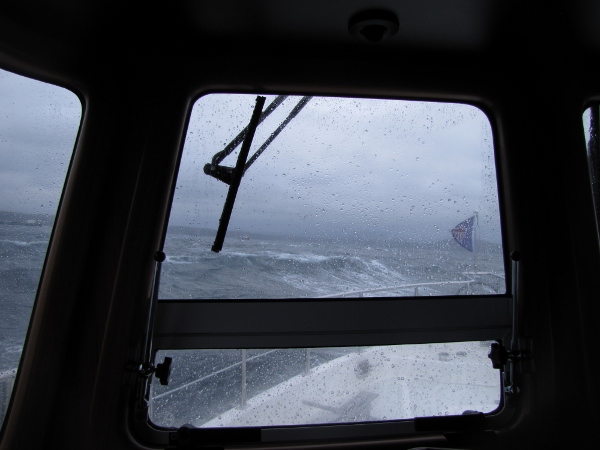.jpg)
On our Christmas trip to Desolation Sound this year, we were looking forward to testing the boat in some rough winter weather. We’ve been out in a few gale warnings, and the boat has handled well, but we wanted something more serious.
We got our chance one morning on a trip from Gorge Harbor to Grace Harbor (map of area). A major SE winter storm was underway, so we set off at first light to check out the conditions. The Strait of Georgia has a reputation for nasty weather year-round, but the north end is particularly bad during southeast winter storms, due to the long fetch and generally stronger winter winds. And opposing current through Discovery Passage and Sutil Channel can make conditions there downright hazardous. We’ve seen conditions so rough in Sutil Channel that the tough little BC Ferry Tenaka, was tacking on the route between Whaletown and Heriot Bay. And many boats have gone down in the tide rips off Cape Mudge. And the “occasional” bit of wood can appear in the area too. Below are a shots from our approach to Heriot Bay a few days later:
.jpg) |
.jpg) |
.jpg) |
As we exited Gorge Harbor that morning, three-to-four-foot waves were blowing into the entry channel with four-to-six-foot waves just outside. The winds were blowing steady in the forties on our nose from the southeast. We started seeing gusts over fifty knots as we approached Sutil Point, where the waves were about ten feet high and closely packed. Fortunately, there wasn’t much wood in the water en route. In the picture below, you can see waves hitting the the back of the boat hard enough to spray up high and pour into the cockpit.
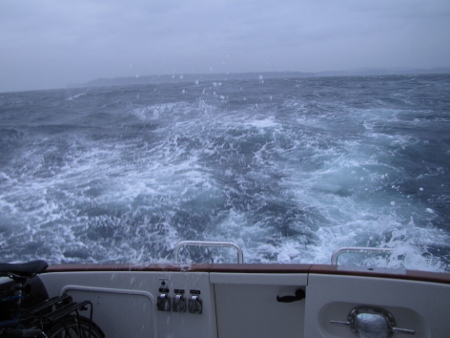.jpg) |
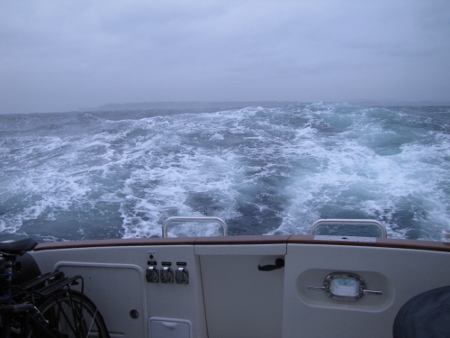.jpg) |
We were heading to Baker Passage north of Hernando Island. We couldn’t just turn east once clear of Sutil Point and put those big seas on our beam. So our plan was to continue on a southeast course towards the northwest end of Hernando Island, then turn northeast to enter the channel. And wouldn’t you know it, the only other boat out there for miles was heading to exactly the same place. The Alaska Titan, barge in tow, was on an easterly course towards Baker Channel as we headed south. The captain radioed us to ask our intentions. We told him that we were a little constrained by conditions and asked if he could take our stern as he proceeded across our course, then we’d turn up the channel and follow him through the the passage.
Once the tug had passed behind, we found a relatively calm set of waves to turn 90-degrees to the northeast and head up into Baker Passage. Conditions were calm in the lee of Hernando, then kicked up again as we exited Baker Passage. But they weren’t as bad they had been on the first leg, and we have an uneventful remainder of the trip to Grace Harbor.
In the screen shot below, the Alaska Titan is the green triangle on the lower left as we are off Sutil Point. The picture on the right was taken just after we’d turned northeast. The barge is visible in the distance, with the tug almost disappearing off the edge of the window.
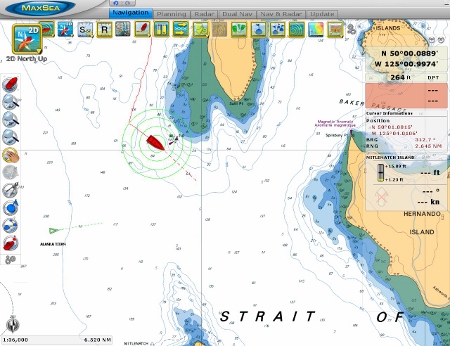.jpg) |
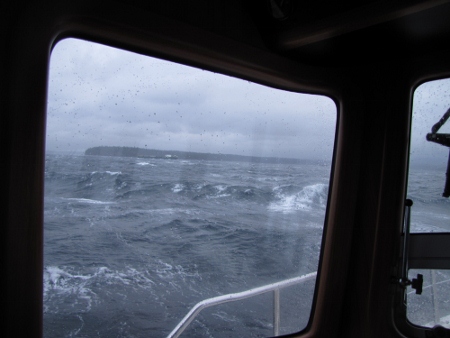.jpg) |
We’d been out in similar conditions in the 4087, and were wondering how the 52 would compare, particularly when the waves tried to twist the boat sideways. It might seem silly to imagine that the 4087 possibly could do better, but with two 270HP engines, the 4087 was surprisingly capable in big seas. Putting one engine full forward and the other in full reverse would generally bring the boat around pretty quickly when needed. With only a single 266HP engine, we thought the 52 might be less maneuverable. But the boat’s weight and that big rudder seemed to make up for the difference in engine configuration. We had no trouble with the waves twisting the boat around, nor with making the 90-degree turn from southeast to northeast off Hernando Island. And another big plus was that we were able to run on autopilot the whole way. The autopilot on the 4087 couldn’t keep up with big seas like that, so we’d have to steer manually, which required much effort at the helm. On the 52, we could just sit back in the pilot house and mostly take in the show.
Here’s some video footage we shot along the way:
You are right to ask Frank. There is absolutely nothing especially resilient about small ships. Even huge 150′ fishing vessels are frequently lost in the Alaskan fishing fleet. Weather is very dangerous and operators of any sized boat need to be respectful of it. From our perspective, part of being respectful of the weather is getting to know how your boat handles rough weather by taking on moderate storms and working up to more serious weather carefully.
Generally, if you are going to do ocean crossings, you will see some 40 to 50 kt winds no matter how careful you are on weather planning so the boat needs to be comfortable in these conditions if ocean crossing is the plan.
–jrh
It’s interesting to hear you deliberately stressing the ship hardware this way. Young aviators do perhaps analogous testing, but are restrained by the proximity of a potentially tragic outcome. Is there something especially resilient about small ships that makes you feel safe while experimenting this way?